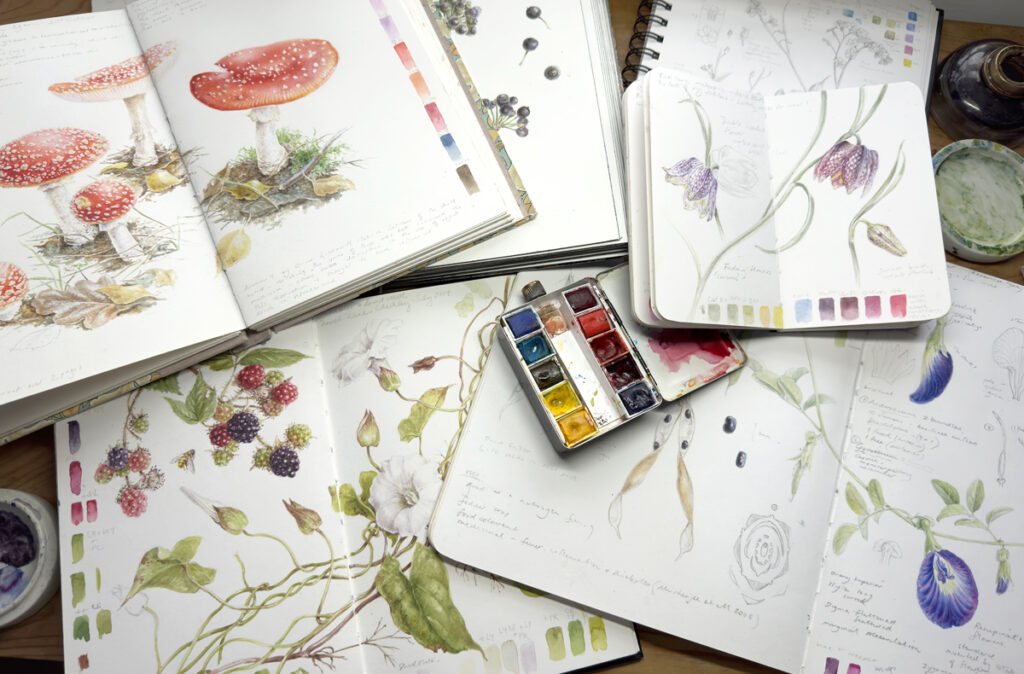
 A collection of different sketchbooks used over the years: from top left in clockwise rotation: two hand-made books (Fly Agaric and Ivy fruits), spiral-bound (Cuckoo flower), pocket-sized (Snake’s Head Fritillary), soft-bound (Asian pigeonwings) and hardbound (Bindweed and brambles). Books created between 2014 and 2024. All books are painted with Winsor & Newton Professional watercolours.
A collection of different sketchbooks used over the years: from top left in clockwise rotation: two hand-made books (Fly Agaric and Ivy fruits), spiral-bound (Cuckoo flower), pocket-sized (Snake’s Head Fritillary), soft-bound (Asian pigeonwings) and hardbound (Bindweed and brambles). Books created between 2014 and 2024. All books are painted with Winsor & Newton Professional watercolours.
As a botanical artist, I’ve always kept some kind of sketchbook, primarily to produce studies as research for final paintings. However, several years ago, I began documenting plants differently, recording plants and other natural objects encountered during local walks across the seasons. This started as a personal pleasure but soon grew into something more meaningful.
During the COVID pandemic, a friend suggested making a sketchbook page weekly, and although initially sceptical, I quickly realised the opportunity it gave me to explore often overlooked plants right on my doorstep. Soon, I was hooked. I didn’t limit myself to wild plants found on walks; I also sketched plants from the garden, which I could paint in the comfort of my studio. I once read that it takes 21 days to form a habit and 90 days to make a lifestyle change, and I believe that there must be some truth to this, because I’m still keeping a regular sketchbook, maybe not every week but at least every other week.
Keeping a sketchbook this way has been one of the most rewarding parts of my work. I’ve drawn and painted hundreds of species, and every page holds memories. Sometimes, these sketches evoke memories of childhood or other life events. For example, drawing dandelion clocks brought back vivid memories, reminding me of how much children love them. I even went on to document multiple dandelion species after learning that there are around 240 varieties in the UK alone.
When it comes to sketchbook choice, I initially used spiralbound, ready-made sketchbooks but was often frustrated with the paper quality. About 10 years ago, I discovered the Stillman & Birn Zeta books, with their 270gsm paper weight suitable for wet media. I began with their hardcover version and then moved to the softback, which sits flatter – ideal if, like me, you like to paint across the central gutter of the book. Today, I still use these books and carry a pocket-sized Zeta book for quick studies. The smooth paper is essential for a botanical artist, as it allows for the fine detail required. I’ve also enjoyed using Stillman & Birn’s Nova Trio, a sketchbook with coloured paper (grey, beige, and black) that’s perfect for studies of white flowers.
More recently, I discovered the hardbacked Etchr Hot Pressed books, which also come in a pocket-sized hardback version. The paper has a slightly more natural white hue than Stillman & Birn, which I enjoy for small tonal studies in black or walnut ink and graphite. Eventually, I progressed to making my own sketchbooks, which was easier than I’d anticipated. This allowed me to use my favourite hot-pressed papers, including Saunders Waterford High White, Stonehenge Aqua, and Arches Satine, all 300gsm. I find that papers lighter in weight can buckle with too much water, while heavier ones are too thick to bind into a book. Each of these papers has unique qualities: Saunders is robust and can withstand a lot of blending and moving paint around but it has a slight tooth compared to other hot-pressed papers, which can make the finest details a little more difficult to achieve; Stonehenge allows for intricate detail but isn’t as durable as Saunders; Arches strikes a balance, offering both toughness and fine detail. Paper choice is personal though, so if you do decide to make your own book, use what suits you best.
To construct the books, I experimented with different stitching methods, starting with Coptic stitch and later moving to a four-needle Japanese butterfly stitch, which, though it sounds complex, is simpler than Coptic and sits flatter. For beginners, the easiest option is the concertina sketchbook, which I highly recommend, if you are keen to get started with handmade sketchbooks. There are many resources online and in books to demonstrate the different methods for making sketchbooks.
If you’re thinking of starting a sketchbook, I can’t recommend it enough. My advice is to avoid setting too many rules – enjoy the process and experiment, as this will help you find your style and approach. I’ve noticed that some students struggle to keep the momentum, so avoid over-planning. Also, remember that you don’t have to complete all sketches outdoors; it’s perfectly fine to bring a plant inside to work on. Finally, keep in mind that sketchbook pages aren’t finished artworks – they’re explorations. Be prepared for mistakes; this is part of the learning process, and imperfect pages are just part of the journey.
Dianne is a British botanical artist who originally trained as a ceramics painter. She became a freelance artist and illustrator in the 1990s and has focused on botanical work since around 2000. She is a member of the Linnean Society, the Society of Botanical Artists, and the Botanical Artists Society Singapore, and her work is held in many collections. You can see more of Dianne’s work at: diannesutherland.com and botanicalart-online.com
Instagram: diannesutherlandartist
Facebook: Dianne Sutherland Artist
Love what you’re reading? Join the SAA to unlock even more benefits! As a member, you’ll gain access to exclusive step-by-step tutorials and videos, discounts on art supplies, and inspiring competitions. Plus, receive your subscription to Paint & Create magazine and join a vibrant community of fellow artists. Don’t miss out—become a member today!
Notifications